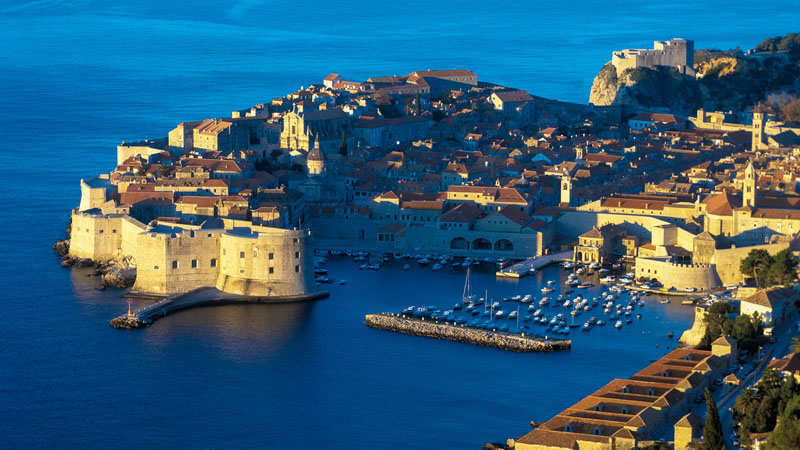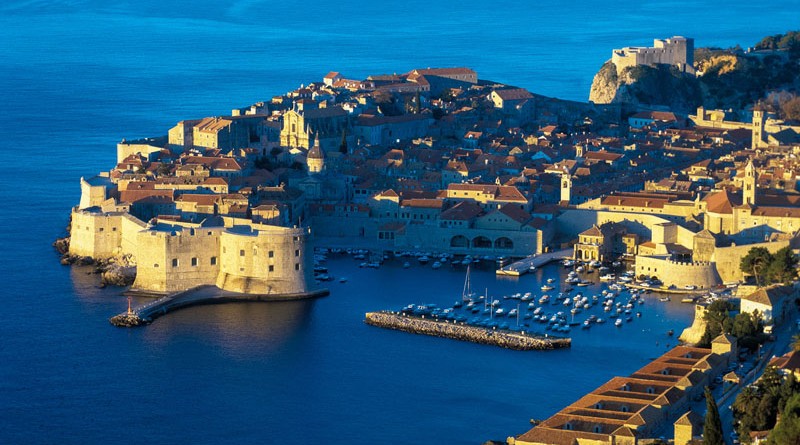Dubrovnik General information
Dubrovnik – the city of a unique political and cultural history (the Dubrovnik Republic, the Statute from 1272), of world-famous cultural heritage and beauty (inscribed on the List of World Heritage Sites by UNESCO) – is one of the most attractive and famous cities of the Mediterranean. Apart from its outstanding natural beauties and well-preserved cul-tural and historical heritage, Dubrovnik also offers high-quality visitor opportunities. It is also the city of hotels, of high ecological standards and tourist programs, and is equally attractive in all seasons. Its geographical isolation is compensated by high traffic and communication standards – especially through air traffic and fast hydrofoil boats. The tourist development of Dubrovnik started before the First World War; quite soon, the exclusiveness of its attractions made Dubrovnik a powerful international tourist centre.

The sightseeing of Dubrovnik and its monuments requires several days. However, already a walk through Stradun, through narrow streets and small squares, monumental ramparts and fortreses, provides enough opportunities to experience the millennial beauty of its shell-shaped urban core, centuries of building, stone-cutting, carving and engraving, the history of the Duke’s Palace, libraries, the oldest pharmacy in the south of Europe, etc. Dubrovnik offers individual choice among numerous museums and galleries, which contain the jewels of Croatian heritage. The Dubrovnik Museum in the Duke’s Palace keeps 15,500 exhibits in its cultural and historical department. A collection of furniture from the 17th-19th century, uniforms of dukes and councillors, aristocratic garments and many other items are exhibited in the authentic halls of the palace. The Maritime Museum (situated in the fortress Sveti Ivan) has a number exhibits on a permanent display, related to the maritime affairs of Dubrovnik and Croatia on the whole, with a particular emphasis on the history of the Dubrovnik Republic. The museum of the Franciscan monastery keeps all inventories of the old pharmacy, as well as the works of Dubrovnik jewel-lers, painters and embroiders. The museum of the Dominican monastery exhibits valuable examples of Dubrovnik painting from the 15th and the 16th centuries, as well as sculptures, jewellery, manuscripts, incunabula and notes (music). The treasury of the Dubrovnik cathedral keeps the relics of St. Blaise, patron of Dubrovnik, and numerous paintings and works of art. The Rupe Ethnographical Museum presents traditional occupations and the rural architecture of the region of Dubrovnik, national costumes and hand-made textiles. Very attractive is also the Aquarium of the Institute of Biology, situated in the fortress Sveti Ivan, comprising interesting marine species. Dubrovnik has a number of churches, monasteries and hotels scattered all over the town. Its coastal belt is adorned with several marinas, piers and promenades. Because of a magnificent view on the mediaeval Dubrovnik, a walk along the town ramparts is a must for each visitor. A great number of Dubrovnik restaurants and taverns offer delicious specialities of local and international cuisine. Sports and recreational facilities include playgrounds, courts and requisites for all sports in the sea and on the ground, from tennis and table tennis to sailing and yachting. There are also several gyms and fitness centres with swimming pools, saunas, massage, aerobics, solarium, box gyms, etc. Dubrovnik is famous for quality hotels. Most of them are situated on the Lapad peninsula and in the area of Ploce, southeast of the old town. The hotel complex Dubrava – Babin Kuk on Lapad has all features of a small town. It has a shopping centre, a bank, an out-patient department, many restaurants and cafés, and a street called the “New Stradun”, which connects all hotels. Dubrovnik is the city of an outstanding cultural and artistic life. The most important event in the cultural life of the city is the Dubrovnik Summer Festival (10th of July – 25th of August), traditionally held since 1950. It is a theatre and classical and folk music festival, since 1956 included in the calendar of world festivals and as such one of the most famous cultural events in the world. Concerts and other performances take place on open stages in the town (Gunduliceva Poljana, Drziceva Poljana, Lovrijenac, Revelin) or in beautiful interiors of the most famous buildings (Duke’s Palace, cloisters, churches). The repertoire includes works of Croatian and world classics, performed by the leading personalities from Croatia and abroad, including a number of world-famous actors, directors, conductors, etc. So far several hundreds of them have performed in Dubrovnik. An important part of the Festival are performances of local (Lindo, Lado) and foreign folk music ensembles. The artistic life of Dubrovnik is characterized by numerous exhibitions taking place throughout the year. Apart from already renowned galleries – the Art Gallery (Put Frana Supila 23), its exhibition space Luza Art Centre (Stradun), Sebastian – occasional and permanent exhibitions are also held in other spaces as well. Very famous are also Dubrovnik carnival festivities – so-called Dubrovnik “karnevo” (local variant of the word “carnival”), held ever since the early Middle Ages, when they were brought from the neighbouring Italy. Another important event is the Feast Day of St. Blaise, also the Day of Dubrovnik (3rd of February). The feast takes place for the whole week, including religious ceremonies, a procession through the town, concerts, sports events, entertainment and carnival programs. Excursions to Dubrovnik during that week are regularly organized. In the vicinity of Dubrovnik, in the gorge of the Ombla river, is Miho Pracat ACI Marina; it has 450 berths in the sea and 250 places on the land. Boaters may also use Dubrovnik Marina. DUBROVNIK, a town, port and tourist centre of the southern Croatian coast. It lies at the foot of the limestone Srd Mount (412 m), in a valley enclosed to the south-west by the Lapad plateau and a smaller reef with the oldest part of Dubrovnik. The ancient town core was connected with the suburban zone on the other side of the valley by levelling and filling up of a marshy valley between the Gruz Bay in the north and Stari Porto (Old Port) in the south, as well as by the construction of the Placa (Stradun). Stradun thus became the centre of the town and its main street, connecting two opposite town gates: the Ploce Gate in the east and the Pile Gate in the west. Upon the construction of the port in the Gruz Bay, Gruz was gradually annexed to Dubrovnik and became an integral part of the town. Later on, Dubrovnik extended also to the Lapad peninsula, to lower parts of the Srd slopes and outside the town ramparts toward Zupa. The climate of Dubrovnik is characterized by warm and dry summers and mild winters. The average air temperature in the coldest month (February) is 4.6 °C and in the warmest month (August) 26.2 °C. The cold half of the year accounts for 68 % of the total annual rainfall; the spring accounts for 29, the summer for 14, the autumn for 26 and the winter for 37 rainy days out of the total number of 105 rainy days. Snow occurs extremely rarely; with 2,554 hours of sunshine a year, Dubrovnik ranks among the sunniest towns of southern Europe. In July it has 12.4 hours of sunshine a day, like Alexandria in Egypt. The vegetation is subtropical and extremely luxuriant (olives, almonds, citrus fruit, rosemary, laurel, holm oak, pine, stone pine, cypress). Southeast of the old part of the town is a tourist zone called Ploce (hotels and beaches), west of it is Lapad (sports facilities, hotels, beaches, walking trails), while northwest of it is the Gruz port and Gruz. Economy is based on tourism and seafaring. The town has a number of cultural and educational institutions: the Nautical College, the Tourist College, the University Centre for Postgraduate Studies of the University of Zagreb, the Institute of History of the Croatian Academy of Arts and Sciences, the Dubrovnik Summer Festival and other. Dubrovnik has a town port, the port of Gruz and a marina. The old town port is protected by the Porporela breakwater; yachts drawing up to 3 m may dock in it; smaller ships are docked in the cove of Gornja Bocina. The port of Gruz is a trading port, situated 2.5 km northwest of the ancient town core of Dubrovnik. Dubrovnik Marina is located in Komolac, in the interior part of Rijeka Dubrovacka, about 4 km from the entrance to the port of Gruz. Dubrovnik is located on the main road (M2, E65). The Dubrovnik airport is located in Cilipi.
www.croatia.hr
